In 1958, the Conference on the Peaceful Uses of Atomic Energy was held by the United Nations in Geneva, Switzerland. The conference played a pivotal role in turning fusion energy research from a secretive, national effort into a globally shared scientific endeavor aimed at developing a clean and sustainable energy source [1].
Currently, there are hundreds of fusion experiments being carried out worldwide, exploring a wide range of magnetic fusion concepts [2,3,4]. International collaboration in fusion research is stronger than ever, contributing to a vast accumulation of knowledge and understanding in the field. After almost 70 years of research and development (R&D) in fusion energy, global interest in the field is reaching new heights, driven by growing support from both the public and the private sectors. In the United States, private companies are working on utility-scale pilot plants that could be launched by the 2030s. Nations with advanced fusion programs are also competing at an unprecedented level, aiming to build the first commercial fusion power plant by 2050.
The International Atomic Energy Agency (IAEA) and the International Energy Agency (IEA) have established frameworks to encourage and facilitate international collaboration on various aspects of fusion research. These programs cover a wide range of topics, including plasma physics, materials science, coolant systems, power plant designs, computational modeling, nuclear data libraries, safety protocols, waste management, decommissioning processes, as well as regulations and licensing [5,6].
A Brief History of Fusion Concepts
Magnetic fusion needs confinement for the nuclear reaction to occur in such a way that the output energy is greater than the input.
Until the 1960s, only four magnetic confinement concepts were developed on a global scale: the tokamak, stellarator, pinch, and mirror. However, since the 1970s, additional designs have been explored, including the Spherical Torus (ST), Reversed-Field Pinch (RFP), the Spheromak, Field-Reversed Configuration (FRC), and Tandem Mirror (TM) [7]. Over the last five decades, all seven of these magnetic confinement concepts, shown in the figures below, have undergone significant modifications. In the early 2000s, the Magnetized Target Fusion (MTF) concept emerged, blending both magnetic and inertial fusion approaches.
The tokamak configuration
The tokamak is a toroidal device where strong magnetic fields confine plasma in a donut-shaped chamber. Its configuration is based on a combination of external magnets generating a toroidal magnetic field and a plasma current that produces a poloidal magnetic field. These two fields are the cause of its stability. Due to its simplicity, the tokamak has become the most widely studied and promising fusion device.

Fig. 1: The tokamak configuration with the toroidal coils (red), the central solenoid (grey) inducing a toroidal plasma current, and the shaping coils (blue). [11]
A tokamak is one of the most advanced and promising configurations for producing controlled nuclear fusion. The main strengths of the tokamak configuration for fusion energy production include:
1. Well-Established Design: The tokamak is the most researched and developed fusion design, with decades of experimental knowledge. This extensive experience has led to the development of advanced control mechanisms and optimized designs for sustaining plasma for longer periods.
2. High Plasma Temperatures: Tokamaks can generate and maintain the extreme temperatures (around 100 million degrees Celsius or higher) required for fusion reactions. This is crucial for overcoming the Coulomb barrier to allow hydrogen nuclei to fuse and release energy.
3. Proven Scalability: Tokamaks have been successfully scaled from small research reactors to larger experimental reactors like the International Thermonuclear Experimental Reactor (ITER). This scalability is key for future commercial fusion power plants.
4. Self-Sustaining Fusion (Burning Plasma): The tokamak configuration can achieve ignition, where the energy produced by the fusion reactions is sufficient to maintain the plasma temperature without needing external heating. This self-sustaining burning plasma is a critical milestone for practical fusion energy.
5. International Collaboration and Support: Due to its strong track record and scalability, the tokamak configuration has garnered significant international support, with large-scale projects like ITER (International Thermonuclear Experimental Reactor) and JET (Joint European Torus) leading the global fusion research efforts. This has resulted in a wealth of shared knowledge and resources.
The stellarator configuration
The stellarator also confines plasma in a toroidal shape but without relying on a plasma current. Instead, it uses complex external magnetic coils to twist the magnetic field lines, making the system stable but presenting significant design and construction challenges. On the other hand, the inexistence of a current makes it free of disruptions, which presents a significant challenge for the tokamak configuration.
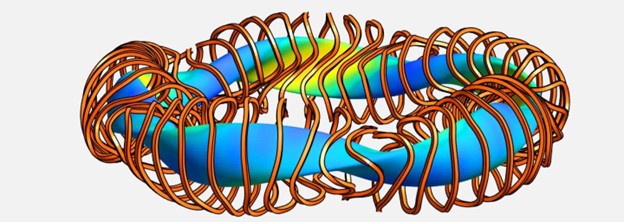
Fig. 2: A generic layout of a stellarator concept, showing the plasma in blueish colors and magnetic coils twisted shape in reddish colors.
The Spherical Tokamak configuration
A noteworthy variation of the tokamak is the Spherical Torus (ST), which features a much smaller central stack, resulting in a more compact, 'spherical' design. This configuration seeks to enhance confinement efficiency while reducing both the size and cost of fusion devices. An ST layout is shown below.
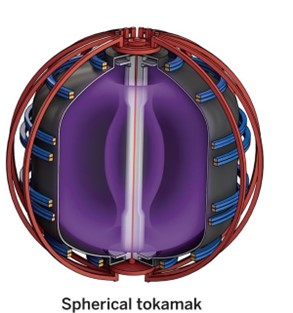
Fig. 3: A spherical tokamak is characterized by its small center stack and thus its compact shape [12]. The toroidal magnetic field is generated by toroidal coils and the plasma current produces the poloidal magnetic field as in a 'normal' tokamak.
The Reverses-Field Pinch configuration
Another alternative is the Reversed-Field Pinch (RFP), shown in the figure below, which does not have a toroidal magnetic field. While similar to the tokamak in many respects, the RFP's magnetic configuration differs by reversing direction near the edge of the plasma. This reversal reduces the need for external magnetic fields, though maintaining stability remains a significant challenge.
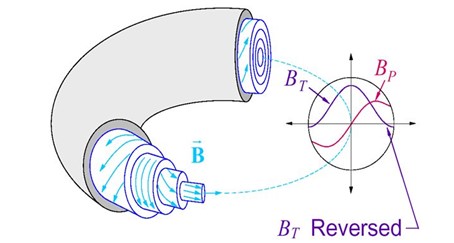
Fig. 4: The RFP configuration is characterized by the absence of toroidal magnets, both poloidal and toroidal magnetic fields are produced by a current in the plasma. [13]
The Spheromak configuration
The Spheromak offers yet another approach, characterized by a compact, self-organized configuration. It generates both toroidal and poloidal magnetic fields through plasma currents, hence, no need for external magnets. While simpler in design than the tokamak and stellarator, the spheromak still requires further development to achieve adequate plasma stability. Moreover, in contrast, the RFP, confines plasma in a cylindrical shape, with closed field lines that reverse at the boundary. This design offers a simpler geometry and allows for high plasma pressure but, like other designs, grapples with stability and confinement issues.
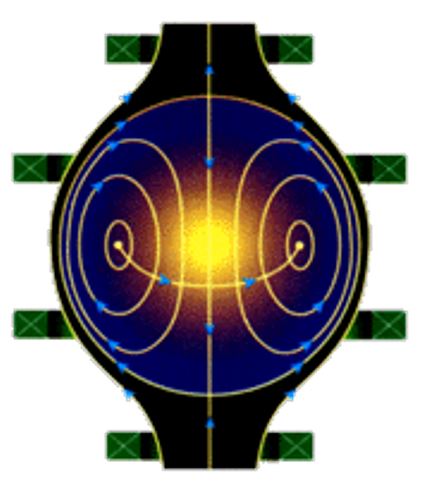
Fig. 5: The Spheromak configuration with almost a spherical vacuum chamber. [14]
The magnetic mirror configuration
The magnetic mirror employs a linear, cylindrical chamber to trap plasma, with magnetic fields stronger at the ends to reflect the plasma back toward the center. It is illustrated below. While it has certain practical applications, mirror confinement has struggled to maintain plasma efficiently enough for fusion. A more advanced iteration, the tandem mirror, improves on this concept by placing two mirrors at either end of the chamber to better trap and confine the plasma. However, despite its potential, it remains technically complex and less widely explored than the tokamak or stellarator.
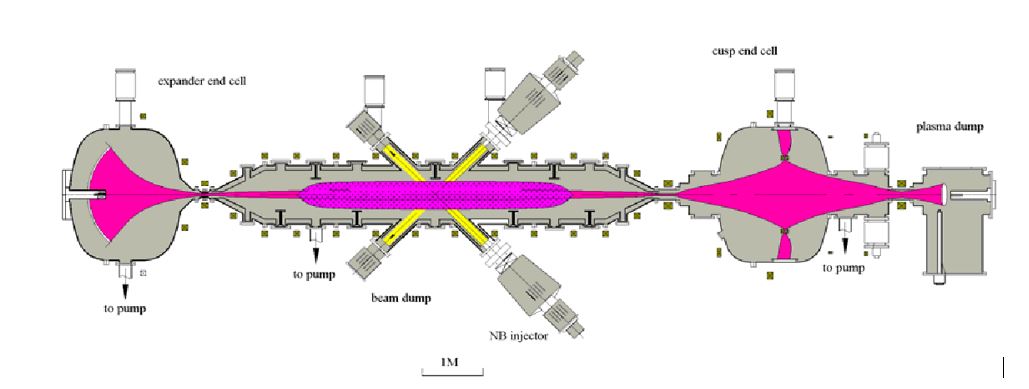
Fig. 6: Basic magnetic mirror machine using two neutral beam (NB) injectors and an axial non-uniform magnetic field. [15]
Magnetized Target Fusion configuration
The Magnetized Target Fusion (MTF) emerged as a hybrid approach, combining elements of both magnetic and inertial confinement. In MTF, plasma is magnetically confined in a small volume, then rapidly compressed by an external driver, aiming to reach fusion conditions through both magnetic and pressure-based confinement methods.


Fig. 7: Schematic of the magnetized target fusion configuration where plasma is injected from top and bottom and the confinement is driven by pneumatic pistons [17].
Experimental Fusion Facilities
Globally, the tokamak design represents approximately 90% of fusion research efforts. Since 1957, tokamak experiments have been constructed and operated in various countries, including Russia, the US, the UK, Japan, Italy, Germany, France, China, Korea, Mexico, Canada, India, the Czech Republic, Portugal, Switzerland, and Brazil [3,4]. These experiments have played a crucial role in advancing magnetic fusion science, however, the production of electric energy from fusion has yet to be demonstrated. Several large-scale experiments have adjusted their technical programs in more recent decades, to support the International Thermonuclear Experimental Reactor (ITER) [8], as well as facilities such as the Pilot Plant, Prototype, and DEMO, which must be completed before the first commercial fusion power plant can be built. In southern France, 35 nations are collaborating to construct ITER, which will be the largest tokamak experiment in the world [9]. It is necessary however, to be aware of the challenges that could hinder progress in the field, which include achieving long-pulsed or steady-state operation, developing low-activation radiation-resistant materials, ensuring high-temperature blanket systems with significant tritium production, creating durable plasma-facing components that can withstand high heat flux, implementing comprehensive waste management strategies, and devising rapid maintenance protocols.
Fusion Fuel Cycles
The first generation (GEN) of fusion facilities relies on deuterium-tritium (D-T) fuel, which is the most accessible and undemanding plasma ignition for fusion on the commercial scale. Hence, the most viable approach to fusion studies and experiments currently relies on the D-T fuel cycle. The D-T fusion reaction releases vast amounts of energy and 14 MeV neutrons. Deuterium is quite abundant in seawater, but tritium does not exist in nature in any appreciable quantity. Since the cost of purchasing tritium is prohibitive, it must be produced from lithium by capturing neutrons in a blanket surrounding the plasma.
The 2nd and 3rd GENs of fusion facilities include the deuterium-deuterium (D-D), deuterium-helium-3 (D-3He), proton-boron-11 (p-11B), and 3He-3He fuel cycles (Fig. 2.3). Experimental studies of D-D fusion have already been conducted and fully demonstrated with increasing accuracy in several tokamak experiments, including TFTR in the US and JET in the UK. The Japanese JT-60SA experiment, currently the largest operational tokamak, achieved its first plasma in late 2023 and will transition to using D-D fuel after completing its hydrogen phase [10]. In ITER, D-D fuel will be used for several years before moving to the final D-T phase. It is important to note that the second and third generations will be greatly simplified due to less 14 MeV neutron production and thus the absence of a tritium breeding blanket.

Fig. 8: The reaction rate for different reactions is plotted as a function of the temperature
Worldwide Timeline for Fusion Energy
Since the 1970s, countries with robust fusion programs have been constructing plans aimed at operating fusion power plants within the coming 50 years. Although this timeline has undergone several changes and shifts in the previous decades, renewed optimism about fusion has emerged in recent years, making the future of fusion energy increasingly promising. Strong evidence shows a commitment to systematic progress and investments at the levels needed to accelerate advancements across all areas of fusion technology. Today, enthusiasm for fusion energy is at an all-time high, and the race to build commercial fusion power plants by 2050 is intensifying.
Fusion technology advancements still necessitate extensive R&D programs and resources before fusion can become fully reliable in terms of providing energy and electricity needs [11,12]. This state of the field has fostered international collaborations between pro-fusion institutions [13], to strive for practical solutions to the impending scientific and technological challenges that the worldwide fusion community has been facing for decades.
The figure below illustrates the public fusion initiatives (i.e., funded mainly by governments) pathways to fusion energy across several international programs. There is broad consensus within the global fusion community that a next-step facility—whether a Pilot Plant, Prototype, or DEMO—is essential for minimizing the technical and programmatic risks linked to the first commercial fusion power plant. In addition to ITER and other operational tokamak experiments, there is a crucial need for numerous small-scale, technology-focused R&D efforts to bridge the significant gap between current fusion experiments and energy-producing next-step facilities. It should be noted that private fusion initiatives are quoting shorter timelines for their devices to deliver commercial fusion energy, ranging from as early as the end of this decade or the middle of next one.
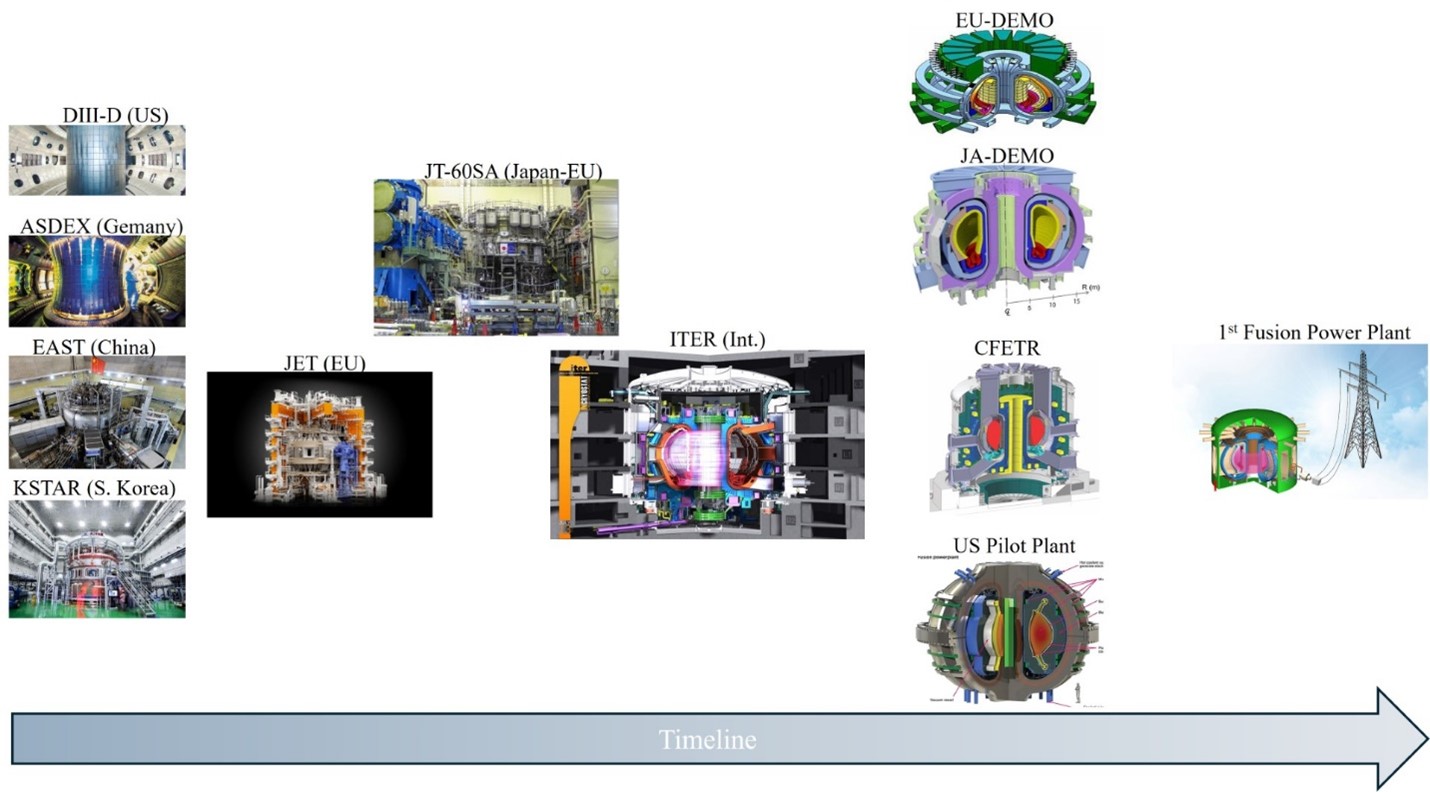 Fig. 9: Worldwide publicly-funded pathways from operational tokamak experiments and ITER to first-of-a-kind power plants. Designs are not to scale.
Fig. 9: Worldwide publicly-funded pathways from operational tokamak experiments and ITER to first-of-a-kind power plants. Designs are not to scale.
The Multidisciplinary nature of fusion energy research
Fusion energy is a field that combines multiple scientific and engineering disciplines, each contributing unique expertise to achieve the common goal of clean energy production. This innate collaborative nature of the field ensures that Middle Eastern countries can leverage their existing capacities and specialized knowledge to advance fusion technology.
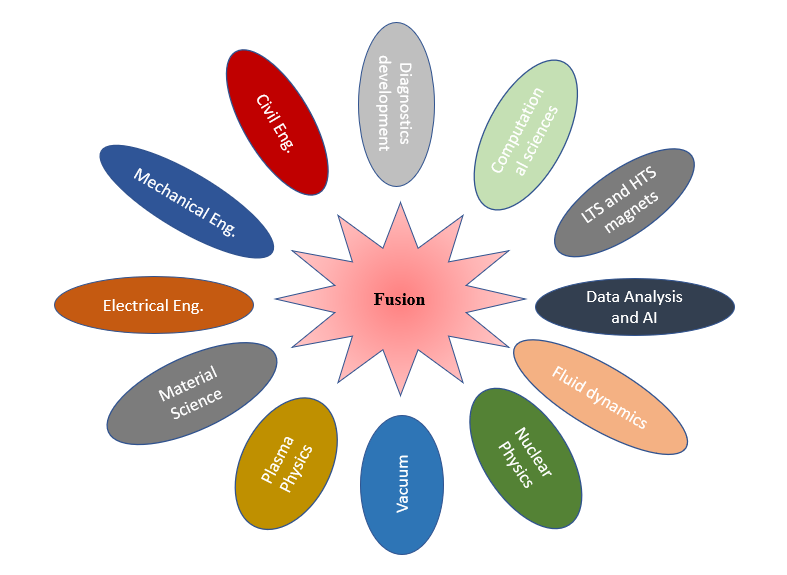
Fig. 10: Various fields that are relevant in fusion energy research.
For instance, mechanical engineers can help design and maintain the complex systems and machinery required for fusion reactors. Their expertise ensures the structural integrity and reliability of components subjected to extreme conditions, such as high temperatures and pressures, within the fusion reactor.
Electrical engineers are also pivotal in developing and maintaining the power systems that drive the reactors and the sophisticated electrical infrastructure necessary to support the high-power requirements of fusion experiments.
It is also important to note that fusion reactors operate in high-vacuum environments to prevent contamination and maintain the purity of the plasma, therefore, experts in vacuum technology are needed to design and maintain the systems that create and sustain these conditions.
Additionally, developing sophisticated diagnostic tools is crucial for monitoring and controlling plasma. These tools provide real-time data on plasma conditions, helping to optimize performance and ensure safety.
On the computational front, scientists also largely contribute by creating and optimizing the models that simulate fusion reactions and predict reactor behavior. High-performance computing (HPC) enables the analysis of complex physical phenomena, guiding experimental design and optimizing reactor operation. Computational simulations are essential for understanding the interactions within the plasma and the overall reactor environment. As for the experimental data produced by fusion experiments, data analysis and artificial intelligence (AI) play critical roles in processing vast amounts of data. These technologies enhance the decision-making process, enabling more efficient and effective fusion research and development.
The major aspect of fusion energy is the physics behind it. Understanding the behavior of plasmas is essential for controlling the particle and the power balance. Their research aims at understanding and controlling the plasma to sustain fusion reactions. Nuclear physicists study the interactions of neutrons with reactor materials and the surrounding environment, helping to develop methods to manage and harness the energy produced, in collaboration with material scientists who can develop and test new materials that can endure these conditions, ensuring the longevity and safety of reactor components.
The multifaceted nature of fusion energy means that contributions from various fields are crucial for its success. The pursuit of fusion energy necessitates leveraging national strengths to advance this technology and contribute to a cleaner, more sustainable energy landscape.
Fusion and other fields
The pursuit of fusion energy brings together a diverse array of disciplines, each contributing its unique expertise to overcome the scientific and engineering challenges involved. Observing natural and man-made plasmas aids our understanding and facilitates the development of fusion and plasma-related technologies.
.png)
Fig. 11: The various non-fusion areas that benefit from the development of fusion.
Astrophysics, for instance, provides insights into the natural fusion processes occurring in stars, including our sun. By studying stellar fusion, astrophysicists contribute valuable knowledge about the fundamental principles of fusion reactions, energy production, and plasma behavior. Additionally, the study of space plasmas, such as those found in the solar wind and magnetospheres, provides valuable information about plasma dynamics and behavior in different environments. Another example of plasma in nature is the Aurora Borealis, or Northern Lights, which is a natural display of plasma in Earth's atmosphere. Knowledge derived from observing these phenomena aids in understanding and controlling the plasma within fusion reactors, contributing to more stable and efficient fusion reactions.
While fusion and fission are distinct nuclear processes, the study of neutron interactions is crucial for both. Neutron physics research helps us understand their impact on reactor materials and their role in sustaining the fusion process.
This leads to the importance of materials processing in the development of fusion energy. Advanced materials are essential for constructing and maintaining fusion reactors. Materials scientists and engineers develop and process materials capable of withstanding the extreme temperatures, radiation, and mechanical stresses within a fusion environment. Another relevant field is fusion-based propulsion systems which holds promise for future space travel. Researchers in space thrusters and propulsion technologies explore how fusion reactions can be harnessed to propel spacecraft, offering the potential for faster and more efficient space exploration.
All of the aforementioned domains facilitate the improvement of the efficiency and safety of fusion energy, potentially offering new pathways to clean and abundant energy.
References